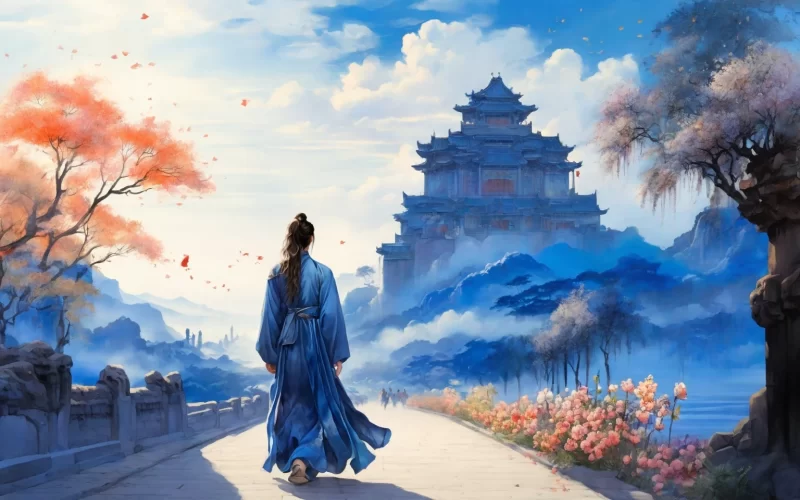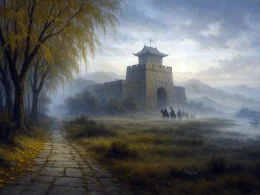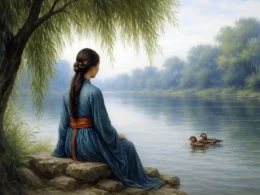We part at the Pavilion Old;
The river flows its water cold.
Above we see trees not in bloom.
Below the vernal grass in gloom.
I ask a wanderer if we go astray;
He says an ancient poet took this way.
The way extends to the west capital,
Where floating clouds at sunset veil the palace hall.
Heart-broken here and now I part with you.
How can we bear to hear songs of adieu?
Original Poem:
「灞陵行送别」
李白
送君灞陵亭,灞水流浩浩。
上有无花之古树,下有伤心之春草。
我向秦人问路歧,云是王粲南登之古道。
古道连绵走西京,紫阙落日浮云生。
正当今夕断肠处,骊歌愁绝不忍听。
Interpretation:
"Farewell at the Old Pavilion" is a farewell poem written by Li Bai. Ba Shui (the Ba River) is located southeast of Chang’an, and was a famous site for farewells during the Tang Dynasty, where scholars and poets of different eras would compose poems to express their feelings. Li Bai uses this backdrop to express his deep affection during the parting, while incorporating scenery descriptions and historical allusions to convey his concern for his friend, worries about the political situation, and nostalgic thoughts about the past.
First Stanza: The Beginning of Farewell and Emotional Build-up
送君灞陵亭,灞水流浩浩。
(Sending you off at Ba Ling Pavilion, the Ba River flows endlessly.)
The first stanza sets the location and environment of the farewell. The description of "Ba Shui flowing endlessly" symbolizes the prolonged and inevitable nature of the departure, establishing a melancholic tone for the entire poem.
Second Stanza: Scenery Reflecting the Emotion of Departure
上有无花之古树,下有伤心之春草。
(Above, there are flowerless ancient trees; below, the sorrowful spring grass grows.)
This stanza contrasts the "flowerless ancient trees" with the "sorrowful spring grass," using imagery to express the sadness of parting. The ancient tree symbolizes the passage of time and the vicissitudes of life, while the spring grass, despite its vitality, takes on a mournful hue in the context of departure.
Third Stanza: Historical Allusion and Emotional Dedication
我向秦人问路歧,云是王粲南登之古道。
(I asked the people of Qin about the fork in the road, and they told me it was the ancient path where Wang Can once traveled south.)
By mentioning the historical figure Wang Can, the poet links his personal sorrow to the experiences of historical figures, deepening the emotional resonance of the poem. Wang Can's journey south to escape turmoil hints at the inevitable departure of the friend, while also reflecting the poet's concerns about political instability.
Fourth Stanza: The Long Ancient Path and the Melancholy Scenery
古道连绵走西京,紫阙落日浮云生。
(The ancient path stretches towards Chang’an, where the sunset over the Purple Forbidden City casts floating clouds.)
This stanza describes the long ancient road and the sunset over Chang’an. The "Purple Forbidden City" symbolizes the imperial palace, while the "sunset" and "floating clouds" metaphorically evoke the impermanence of history and the transient nature of life, creating a solemn and melancholy atmosphere.
Final Stanza: The Heartfelt Pain of Departure
正当今夕断肠处,骊歌愁绝不忍听。
(At this very moment, the pain of parting breaks my heart, and I can no longer bear to listen to the mournful Li song.)
The final stanza uses the image of the "Li song" to bring the emotion of departure to a climax. The "Li song" was a famous tune played during farewells in ancient times, and its sorrowful melody heightens the sense of grief in the poet’s heart. Li Bai directly expresses his profound sadness and reluctance to part with his friend.
Literary Features
- Fusion of Scenery and Emotion
The poem intertwines scenery with emotion, using natural imagery and historical references to deepen the expression of the sadness of departure. - Use of Historical Allusion
By referencing the historical figure Wang Can, the poet ties his personal emotions to a broader historical context, giving the poem a sense of depth and nostalgia. - Symbolism
Images like "Ba Shui," "flowerless ancient trees," "sunset," and "floating clouds" not only showcase the beauty of nature but also symbolize the prolonged nature of farewell and the impermanence of life. - Strong Rhythm
The combination of five-character and seven-character lines creates a rhythmic flow, adding emotional impact to the poem.
Overall Analysis
"Sending You Off at Ba Ling Pavilion" showcases Li Bai’s complex emotions during parting, weaving together historical allusions and personal feelings. The imagery of nature and the historical references strengthen the poem’s mood, expressing not only the poet’s sorrow at parting from a friend but also his concern for the turbulent political situation. Through this poem, Li Bai expresses a nuanced inner world that is filled with both personal grief and reflections on the state of the nation.
Inspiration
This poem inspires us to cherish the friendships and relationships we have in the present, learning to let go amidst the inevitable separations of life. It also encourages us to reflect on the challenges of history and reality, adopting an open mindset to contemplate deeper values and meanings.
Poem translator:
Xu Yuan-chong(许渊冲)
About the poet

Li Bai (李白), 701 - 762 A.D., whose ancestral home was in Gansu, was preceded by Li Guang, a general of the Han Dynasty. Tang poetry is one of the brightest constellations in the history of Chinese literature, and one of the brightest stars is Li Bai.











